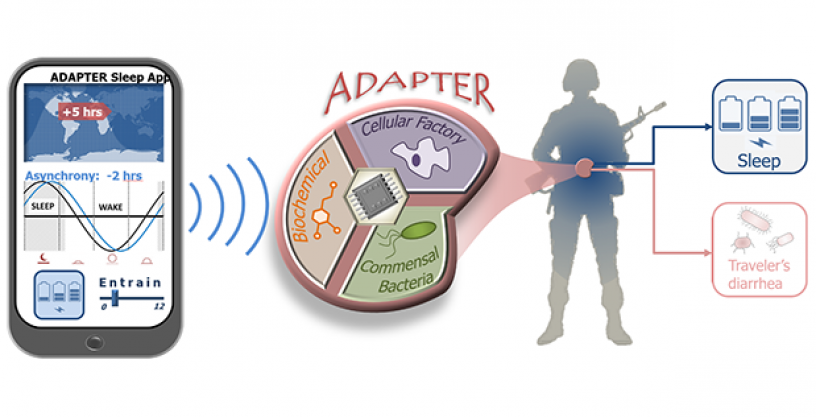
ADAPTER teams aim to develop a hybrid device, controlled by the warfighter, that boosts and extends performance during field forward missions
May 10, 2021
While jet lag and foodborne pathogens are inconveniences for an average traveler, they are critical challenges to operational readiness for a warfighter and can be the difference between mission success or failure. To maximize warfighter performance, the ADvanced Acclimation and Protection Tool for Environmental Readiness (ADAPTER) program will develop systems to provide warfighters control over their own physiology. This program will integrate engineered cells and biochemicals into an internal, bioelectronics carrier that the warfighter can signal, as needed, to initiate the production and timed release of therapies that either eliminate the foodborne pathogens that cause traveler's diarrhea or regulate disrupted circadian rhythms caused by jetlag or shift-work schedules.
Today, DARPA announced the three research teams who will tackle these challenges:
- Northwestern aims to engineer a wirelessly-controlled bioelectronic implant that reduces the time needed to adapt to new time zones or drastic changes in work schedules by releasing peptide-based therapies to harmonize the warfighter’ central and peripheral circadian clocks.
- The Stanford team plans to develop an implantable device that produces and releases melatonin on demand for up to 30 days.
- Massachusetts Institute of Technology researchers will work on a swallowed device that deploys in the gut and then produces compounds that both kill foodborne pathogens and neutralize toxins that may have been released by the pathogens.
“The ADAPTER technology will alleviate operational limitations imposed by human physiology for two high priority military needs – sleep and safe sustenance,” stated Dr. Paul Sheehan, ADAPTER program manager. “Generating the therapeutic system will require both accurate therapies and clear communication between the bioelectronic carrier and the external activator.”
During Phase I, performers will engineer cells to execute the desired biological function. Additionally, teams will develop a bioelectronic carrier that can house the engineered cells and deploy the therapies on demand via secure external activation. During Phase II, performers will integrate the carrier and the engineered cells into a system that delivers physiologically-relevant doses of therapy in a large animal model. The final phase will focus solely on the safety of the ADAPTER system for humans.
“ADAPTER will develop a transient, non-genetic means of extending and enhancing warfighter readiness by reducing the time to reestablish normal sleep after a disruption, such as jet lag or shift lag,” added Sheehan. “It will also provide safe food and water by eliminating the top 5 bacterial sources of traveler’s diarrhea. Both will enhance the agility and mobility of warfighters.”
Additional information on the ADAPTER program is available at: https://beta.sam.gov/opp/c21c517d629541dbba86c58098c72e54/view.
# # #
Media with inquiries should contact DARPA Public Affairs at outreach@darpa.mil
Associated images posted on www.darpa.mil and video posted at www.youtube.com/darpatv may be reused according to the terms of the DARPA User Agreement.
Tweet @darpa
